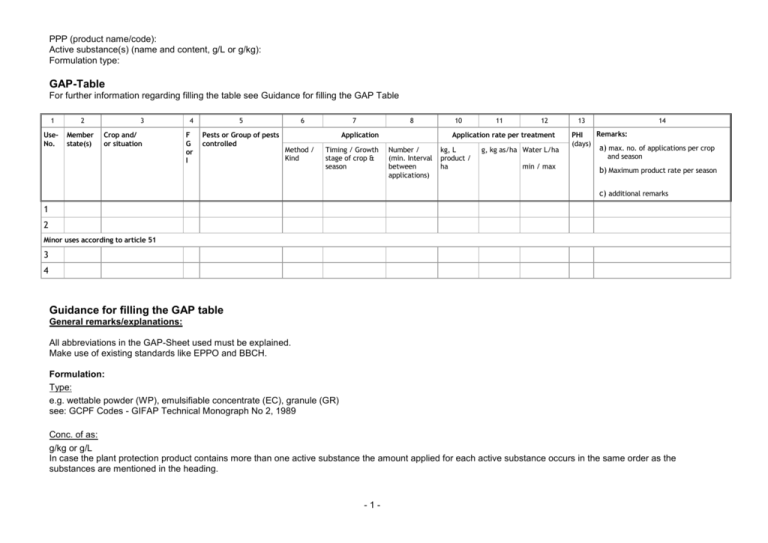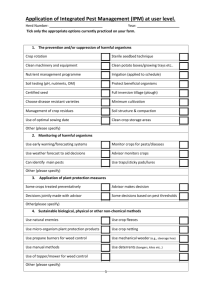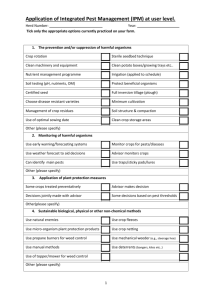PPP (product name/code): Active substance(s) (name and content, g
advertisement

PPP (product name/code): Active substance(s) (name and content, g/L or g/kg): Formulation type: GAP-Table For further information regarding filling the table see Guidance for filling the GAP Table 1 UseNo. 2 Member state(s) 3 4 5 Crop and/ or situation F G or I Pests or Group of pests controlled 6 7 8 Application Method / Kind Timing / Growth stage of crop & season 10 11 12 Application rate per treatment Number / (min. Interval between applications) kg, L product / ha g, kg as/ha Water L/ha min / max 13 14 Remarks: PHI (days) a) max. no. of applications per crop and season b) Maximum product rate per season c) additional remarks 1 2 Minor uses according to article 51 3 4 Guidance for filling the GAP table General remarks/explanations: All abbreviations in the GAP-Sheet used must be explained. Make use of existing standards like EPPO and BBCH. Formulation: Type: e.g. wettable powder (WP), emulsifiable concentrate (EC), granule (GR) see: GCPF Codes - GIFAP Technical Monograph No 2, 1989 Conc. of as: g/kg or g/L In case the plant protection product contains more than one active substance the amount applied for each active substance occurs in the same order as the substances are mentioned in the heading. -1- PPP (product name/code): Active substance(s) (name and content, g/L or g/kg): Formulation type: Explanations to the particular columns: No.: Numeration would be important when references are necessary e. g. to the dossier or to the authorisation certificate. Member state(s): For a better general view of the valid uses for the particular zones/MS it would be helpful to mention both (the zone as well as the MS) in the column. However, to keep the table clearly arranged it seems dispensable to cite the zone; each MS is distinctly allocated to one zone; moreover the zone(s) are cited in the head of the table. Desirably MS are put in order accordant to the zone they belong. Crop and/or situation: The common name(s) of the crop and the EC (EPPO)-Codes or at least the scientific name(s) [EU and Codex classifications (both)] should be used; where relevant, the situation should be described (e.g. fumigation of a structure). In case of crop groups all single crops belonging to that group should be mentioned, (either in the respective table element or – in case of a very extensive crop group - at least in a footnote). In case of crop groups all single crops belonging to that group should be mentioned, (either in the respective table element or – in case of a very extensive crop group - at least in a footnote). If it is not possible to mention all single crops belonging to a crop group (e.g. for horticulture), it should be referred to appropriate crop lists (e.g. EPPO, residue (codex). It would be desirable to have a “joint list” of crop groups for the zones. Exceptions of specific crops/products/objects or groups of these and restrictions to certain uses (e.g. only for seed production, fodder) must be indicated. This column should also include when indicated information concerning “crop destination or purpose of crop”. Conditions / location of use: Outdoor or field use (F), glasshouse application (G) or indoor application (I) “Glasshouse” indicates that the respective trials are acceptable for all zones. As results achieved in compartments without controlled conditions (temperature, light exposure), e.g. simple plastic tunnels [for those GAPs field trials have to be conducted in the respective zone the use is applied for], are not considered to be applicable for use in other zones the kind of glasshouse should be clearly indicated. [Remark: Greenhouse definitions are at the moment under evaluation]. Conditions include also information concerning the substrate (natural soil, artificial substrate). In this column it should also be indicated, whether the product is intended for professional or for non-professional use -2- PPP (product name/code): Active substance(s) (name and content, g/L or g/kg): Formulation type: Pests or Group of pests controlled: Scientific names and EPPO-Codes of target pests/diseases/ weeds or when relevant the common names of the pest groups (e.g. biting and suckling insects, soil born insects, foliar fungi, weeds) and the developmental stages of the pests and pest groups at the moment of application must be named. If necessary – in case of pest groups - exceptions (e.g. sucking insects excluding scale insects) should be indicated. In some cases, the set of pests concerned for a given crop may vary in different parts of the EU region (where appropriate the pests should be specified individually). If the product is used as growth regulator the target organism is the specific cop, whose development should be influenced; the aim could also be e.g. an empty room for treatment. Application details: Method / Kind: Method, e.g. high volume spraying, low volume spraying, spreading, dusting, drench, drilling, high precision drilling (with or without pneumatic systems). Kind, e.g. overall, broadcast, aerial spraying, row, individual plant, between the plant - type of equipment used should be indicated if relevant. Timing of Application / Growth stage of crop & season: Time(s), period, first and last treatment, e.g. autumn or spring, pre- or post-emergence, at sufficient pest density or begin of infection, including restrictions (e.g. not during flowering). Growth stage of crop (BBCH-code, …) – period, first and last treatment. Since the BBCH-codes are accomplished in the individual member states at different time periods the month(s) of application should be indicated in addition. BBCH Monograph, Growth Stages of Plants, 1997, Blackwell, ISBN 3-8263-3152-4 It seems sensible to constrain specifications in this column only to the crop, - information concerning the pest should be dealt in column “pest or group of Pests controlled”. In certain circumstances it might be helpful to give information about the expected rate of interception related to the BBCH codes. In many minor crops no BBCH/interception rate scenarios have been specified so far. This could also simplify grouping for the envelope approach. Number of applications and interval between applications Maximum number of application per growing season used for the named crop/pest combination possible under practical conditions of use. The proposed maximum number in the crop including applications on all pests/targets on the same crop in a growing season should be given in the column “remarks”. -3- PPP (product name/code): Active substance(s) (name and content, g/L or g/kg): Formulation type: In the case of insecticides, it should be clearly indicated whether the displayed number of applications is per season, per crop cycle or per pest generation. Minimum interval (in days) between applications of the same product. The figure for the interval between the applications is to be set in brackets. Application rate per treatment: Application rate of the product per ha: (Maximum) product rate per treatment (usually kg or l product / ha). For specific uses other specifications might be possible, e.g.: g/m³ in case of fumigation of empty rooms or pallox (= big box used for storage potatoes, fruits, roots). Maximum product rate per growing season (especially if limited) or per crop cycle should be cited in the column “remarks”. Especially in three dimensional crops other dose expressions (kg/l per 10.000 m² leaf wall area or kg/l per ha per meter crown (canopy) height) should be given additionally. For seed treatment also the load of product (l/g, kg) per kg, dt or unit treated seed should be stated beside the application rate per hectare. The number of seeds per (seed) unit is to be given. For seed treatment the maximum seed drilling rate (=number of seed sown/maximum seed volume) per row or ha should be indicated. It would also be helpful to indicate whether seeds are surface broadcast or precision drilled. See also EPPO-Guideline PP 1/239 Dose expression for plant protection products. g, kg as/ha: The dimension (g, kg) must be clearly specified by the applicant. (Maximum) dose of a.s. per treatment (usually g , kg or l product / ha) For seed treatment the maximum seed drilling rate (=number of seed sown/maximum seed volume) per row or ha should be indicated. Maximum dose of a.s. per growing season (especially if limited) should be cited in the column “remarks” [as this relates mainly to the product respectively to the crop and not primarily to the specific use]. In case the plant protection product contains more than one active substance the amount applied for each active substance occurs in the same order as the substances are mentioned in the heading. Water L/ha: It should be clearly indicated if a stated water volume range depends upon the developmental stage of the crop (low volume – early crops stage, high volume – late crop stage) which causes a consistent concentration of the spray solution, or if a water volume range indicates different spray solution concentrations. In the last mentioned case extremely low water volumes (indicating high concentrated spray solutions) need to be covered within selectivity trials. -4- PPP (product name/code): Active substance(s) (name and content, g/L or g/kg): Formulation type: PHI (days) – minimum pre harvest interval PHI - minimum pre-harvest interval For some crop situations a specific PHI may not be relevant. If so an explanation (e. g. the PHI is covered by the time remaining between application and harvest.) should be given in the remarks column (e.g. crop harvest at maturity or specific growth stages). Remarks: Remarks may include: Extent of use/economic importance/restrictions e.g. limiting the number of uses per crop and season, if several target pests/diseases are controlled with the same product. Minor uses according to article 51 In case The Netherlands is the reporting Member State, below this row uses should be taken up - that can be regarded as minor according to the Dutch ‘beslisboom’ (see Ctgb website, onder ’Kleine toepassingen’), and - for which the aspect efficacy has not been evaluated (and for which extrapolation is not possible) Additional recommendations: For the description of uses of a PPP the following EPPO Standards should be considered: EPPO Standard PP 1/240 “Harmonized basic information for databases on plant protection products” EPPO Standard PP1/ 248 “Harmonized classification and coding of the uses of plant protection products“ Whereas EPPO Standard PP1/ 248 gives more general information on possible description of uses, EPPO Standard PP 1/240 especially gives an overview of all points necessary to fully understand a use. For EPPO-Guidelines, see: http://archives.eppo.org/EPPOStandards/efficacy.htm For EPPO extrapolation tables, see http://www.eppo.org/PPPRODUCTS/extrapolation/tables.htm For EPPO Plant Protection Thesaurus, see: http://eppt.eppo.org/ -5-








